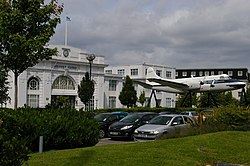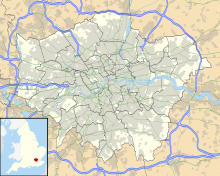RAF Croydon
| Croydon Airport | |||||||||||||||||||
|---|---|---|---|---|---|---|---|---|---|---|---|---|---|---|---|---|---|---|---|
 |
|||||||||||||||||||
| Summary | |||||||||||||||||||
| Airport type | defunct | ||||||||||||||||||
| Serves | London, UK | ||||||||||||||||||
| Location | Croydon | ||||||||||||||||||
| Coordinates | 51°21′23″N 000°07′02″W / 51.35639°N 0.11722°WCoordinates: 51°21′23″N 000°07′02″W / 51.35639°N 0.11722°W | ||||||||||||||||||
| Website | www.croydonairport.org.uk | ||||||||||||||||||
| Map | |||||||||||||||||||
| Location in Greater London | |||||||||||||||||||
| Runways | |||||||||||||||||||
|
|||||||||||||||||||
|
Runway Details:
|
|||||||||||||||||||
Croydon Airport (ICAO: EGCR) was an airport in South London straddling the boundary between what are now the London boroughs of Croydon and Sutton. It was the main airport for London before it was replaced by Northolt Aerodrome, London Heathrow Airport and Gatwick Airport. The terminal building and entrance lodge are Grade II listed buildings.
In 1915 Beddington Aerodrome was established – one of a number of small airfields around London that were created for protection against Zeppelin raids during the First World War. In 1916 a wooden air traffic control and Customs building was built on one of these two aerodromes.Waddon Aerodrome opened in 1918, adjoining National Aircraft Factory No. 1, to serve aircraft test flights. The two airfields were on each side of Plough Lane (the lane running north from Russell Hill near Purley, in the accompanying old map).
The two aerodromes were combined following the end of the First World War to become Croydon Aerodrome, the gateway for all international flights to and from London. The new aerodrome opened on 29 March 1920. Plough Lane remained a public road crossing the site, and road traffic was halted when necessary, first by a man with a red flag and later by a gate. The aerodrome stimulated a growth in regular scheduled flights carrying passengers, mail and freight, the first destinations being Paris,Amsterdam and Rotterdam. Two flights daily from Paris were scheduled for ease of communication with London during the Paris Peace Conference.
...
Wikipedia

